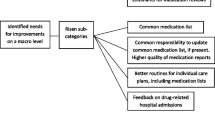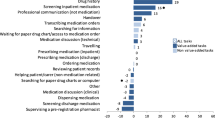Abstract
Background and objectives
Drug and Therapeutics Committees (DTCs), which are essential for ensuring the rational use of drugs (RUD) in hospitals, have recently been established in Laos. Sub-optimal performance had been reported. The aims of this study were to determine those factors in the working environment that relate to DTC performance in Lao hospitals and evaluate whether DTC performance could be improved through an educational intervention utilizing auditing and feedback targeted towards DTC members.
Methods
This was a quasi-experimental (before and after) study. Two central and seven provincial hospitals and the DTC members from these hospitals participated in the study. Performance of the DTCs was assessed by means of specifically developed indicators on structure and process combined with indicators for RUD and adherence to Standard Treatment Guidelines (STG). Data were collected for a 3-month period at baseline and for three consecutive periods thereafter. The results of the first three data collections were shared and discussed with the DTC members during feedback sessions. The DTC members were also interviewed in order to identify factors they thought may have an impact on DTC performance.
Results
Following the intervention, there was a significant improvement in the overall score for DTC performance (p<0.001) and, in particular, in general activity and feedback and drug information to staff. The STG scores also improved (p<0.01). Interviews indicated that one negative factor was the experience of the DTC members being overloaded with other work, resulting in DTC meetings being held irregularly and drawing poor attendance.
Conclusion
Continuous self-monitoring of performance by means of indicators, followed by feedback discussions, is suggested the means of improving the work of the DTC.

Similar content being viewed by others
References
Bero LA, Grill R, Grimshaw JM, Harvey E, Oxman AD, Thomson MA (1998) Closing the gap between research and practice: an overview of systematic reviews of interventions to promote the implementation of research findings. The Cochrane Effective Practice and Organization of Care Review Group. BMJ 317:465–468
Bottiger LE (1981) The Swedish Adverse Drug Reaction Committee: an important tool for safer drug therapy. Qual Rev Bull 7:14–20
Green T, Holloway KA, Chalker J (2004) Promoting drug and therapeutics committees in the developing world (AC 009). In: Second Int Conf Improv Use Med. Chiangmai, Thailand
Holloway KA, Green T (2003) Drug and Therapeutics Committee: a practical guide. WHO, Geneva
Johansson R (2001) The Lao National Drug Policy Project, Phase III 2001–2003, Indicators Lao GPP – 2000, Standard Treatment Guidelines 2, Drug therapeutic committees. IHCAR, Karolinska Institute, Stockholm
Johnston PE (1992) Adverse drug reaction surveillance and risk management. Perspect Health Risk Manage 12:22–24
Kimelblatt BJ, Young SH, Heywood PM, Mandala AR, Gendelman S, Mehl B (1988) Improved reporting of adverse drug reactions. Am J Hosp Pharmacol 45:1086–1089
Laing R, Hogerzeil H, Ross-Degnan D (2001) Ten recommendations to improve use of medicine in developing countries. Health Policy Plan 16:13–20
Ministry of Health (2001) National Health Survey 2000 by the National Institute of Public Health. Vientiane, Ministry of Health, Lao PDR
Muir Gray JA (2001) Evidence-based health care. Churchill Livingstone, London
Mwenesi, HA (1994) The role of drug delivery system in health care: the case of self-medication. Afr J Health Sci 1:42–48
Paphassarang, C, Tomson G, Choprapawon C, Weerasuriya K (1995) The Lao National Drug Policy: lessons along the journey. Lancet 345:433–435
Saine DR (1992) A successful community hospital program for monitoring adverse drug reactions. Top Hosp Pharmacol Manage 12:19–30
Sjöqvist F (1999) The past, present and future of clinical pharmacology. Eur J Clin Pharmacol 55:553–557
Stenson B, Syhakhang L, Erisson B, Tomson G (2001) Real world pharmacy: assessing the quality of private pharmacy practice in Lao People’s Democratic Republic. Soc Sci Med 52:393–404
Syhakhang L, Stenson B, Wahlström R, Tomson G (2001) The quality of public and private pharmacies practices: a cross-sectional study in the Savannakhet province, Lao PDR. Eur J Clin Pharmacol 57:221–227
Syhakhang L (2002) The quality of private pharmacy services in a province of Lao PDR: perceptions, practices and regulatory enforcements. PhD thesis, Karolinska Institute, Stockholm
Thomson O’Brien MA, Oxman AD, Haynes RB, Davis DA, Freemantle N, Harvey EL (2001) Educational outreach visits: effects on professional practice and health care outcomes. Update Software, The Cochrane Library, Oxford, Issue 4, 2001
Tomson G, Paphassarang C, Jönsson K, Houamboun K, Akkhavong K, Wahlström R (2005) Decision makers and the usefulness of research evidence in policy implementation – a case study from Lao PDR. Soc Sci Med 61: 1291–1299
Trostle J (1996) Inappropriate distribution of medicines by professionals in developing countries. Soc Sci Med 42:1117–1120
Wahlström R, Kounnavong S, Sisounthone B, Phanyanouvong A, Southammavong T, Erisson B, Tomson G (2003) Effectiveness of feedback for improving case management of malaria. diarrhoea and pneumonia-a randomized controlled trial at provincial hospitals in Lao PDR. Trop Med Int Health 8:901–909
Weekes, LM, Brooks C (1996) Drug and Therapeutics Committees in Australia: expected and actual performance. Br J Clin Pharmacol 42:551–557
Acknowledgements
The authors of this study wish to acknowledge the Swedish International Development Cooperation Agency (Sida) for funding, and Professor Boungnong Boupha and Associate Professor Kongsap Akkhavong for their supervision of the project. Grateful thanks are also extended to Dr. Bouathong Sisounthone (deceased December 2004), Dr. Phat Keungsaneth and Dr. Sommay Rattanavong as members of the research team and to all DTC Task force and VIP members from the nine DTC units involved in the study.
Author information
Authors and Affiliations
Corresponding authors
Appendices
Appendix 1
Tasks of the Lao Drug and Therapeutics Committees
1. To have an advisory role to the Hospital Board, decision makers and health staff in general |
2. To monitor regularly adherence to indicators for STG and RUD |
3. To monitor regularly drug consumption at various departments of the hospital |
4. To make analyses and report to the head of DTC, who will report to the Hospital Board |
5. To propose (and carry out) interventions/feedback |
6. To take decisions ‐ based on the Lao EDL (Essential Drugs List) ‐ regarding the EDL of the hospital |
7. To develop/improve/follow up on hospital medical routines |
8. To stimulate or to give training/teaching (diagnosis, drugs and treatment) |
9. To provide objective information regarding drug use to the Hospital Board, decision makers and health staff in general |
10. To make a list of anti-dots and to be responsible for emergency kits |
11. To stimulate reporting about adverse drug reactions (side effects) to the DTC |
12. To have knowledge and acceptance about ongoing clinical studies |
13. To co-operate with other Drug Therapeutic Committees |
Appendix 2
Indicators for DTC performance
Indicator 1: DTC structure |
Is the Head of DTC from the Board of Hospital Directors? |
Are doctors, nurses and pharmacists recruited to be DTC members? |
Is there any DTC secretary? |
Indicator 2: DTC report system |
Is there any available agenda of DTC activities? |
Is there any summary of the result of the meeting? |
How often are the DTC reports sent to the upper administrative/clinical levels in the organization? |
Where do DTC report? |
Is there any special report form? |
Indicator 3: DTC activities |
Is there a timetable for meetings within the DTC? |
Number of STG and RUD score collections performed in the last 6 months? |
Are STG books available in all departments? |
What is the percentage of EDL drugs used in the hospital? |
Indicator 4: DTC feedback |
How many feedback sessions were held in the last 6 months? |
What are the contents of feedback? |
What percentages of doctors and nurses participated in the feedback sessions? |
Indicator 5: DTC drug information |
Is there any EDL in the hospital? |
Number of information activities about new drugs and banned drugs are held per year? |
Is there any promotion on the use of a generic name? |
Is there any information concerning to appropriate use of antibiotics and injections? |
Indicator 6: Adverse drug reactions (ADR)/side effects (SE) control |
Is there any person responsible for ADR reporting in the DTC? |
Is there a specific report form? |
Do doctors and nurses know the person where to report an ADR? |
Has the ADR person received any reports? |
Is there any feedback on ADR? |
Are ADR reported to central level ? |
Indicator 7: Monitoring of drug cost/consumption (DDD, daily defined doses) |
How often was there a comparison between departments carried out of DDD/cost consumption for antibiotics? |
How often was there a comparison of antibiotic tablets/injections? |
How often was there a comparison of analgesics DDD/cost between departments? |
Indicator 8: Hospital medical routines (HMR) |
Is the DTC working with one of the 20 HMR ideas suggested (which?) |
Is the DTC working with other HMR ideas (which?) |
Can the DTC show graphic/data/statistics of monitoring? |
Is there any kind of intervention? |
Who did the intervention and when? |
Is there any follow up/monitoring/graphic available? |
Rights and permissions
About this article
Cite this article
Vang, C., Tomson, G., Kounnavong, S. et al. Improving the performance of Drug and Therapeutics Committees in hospitals – a quasi-experimental study in Laos. Eur J Clin Pharmacol 62, 57–63 (2006). https://doi.org/10.1007/s00228-005-0069-8
Received:
Accepted:
Published:
Issue Date:
DOI: https://doi.org/10.1007/s00228-005-0069-8




